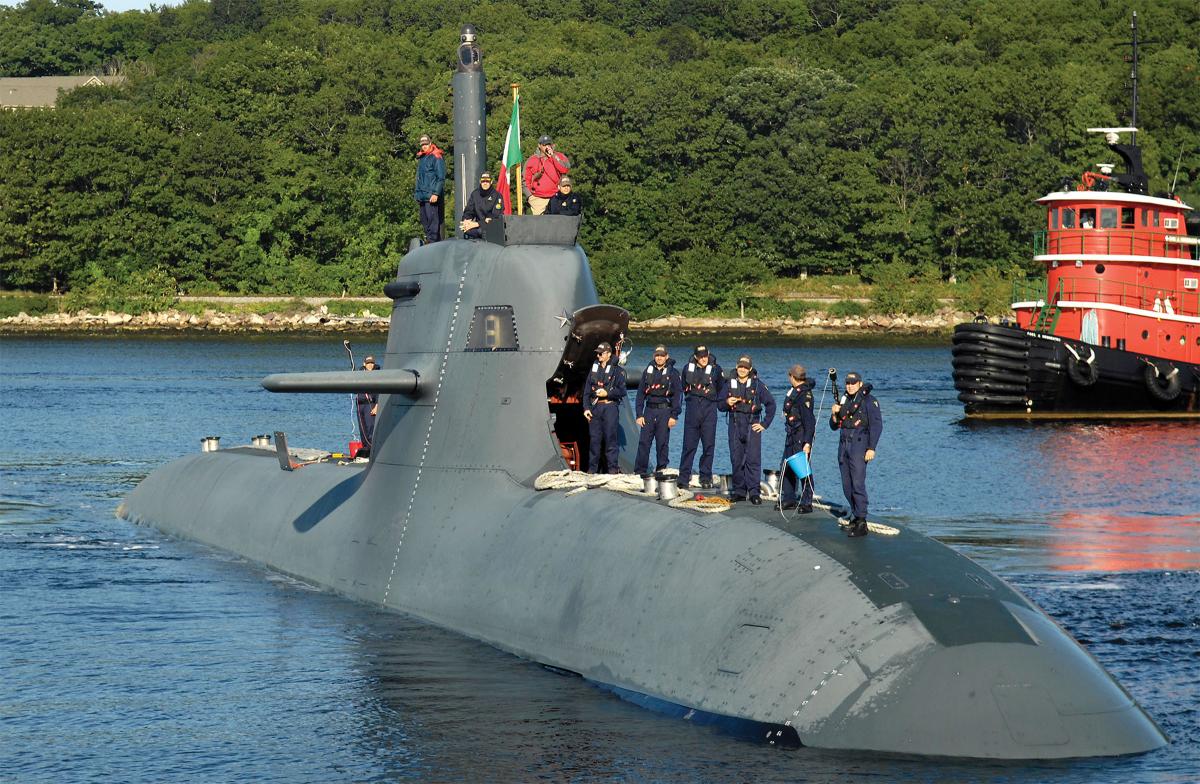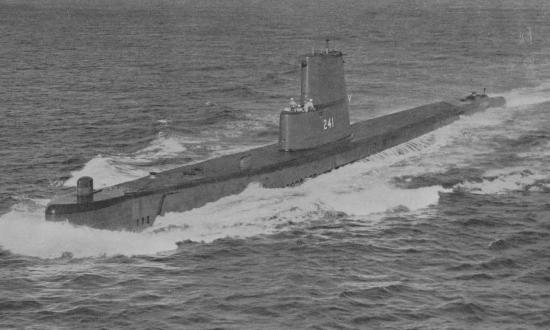Today, the only real difference between a nuclear-powered submarine and a conventional diesel-electric boat is underwater range. Size, performance, noise, layout, weapons, sensors, and so forth are simply the consequences of the type of propulsion adopted. While the nuclear plant’s “kettle” is always boiling, the conventional boat has to let her diesel engine breathe from time to time.
Both systems produce heat to generate power, but while nuclear fuel burns practically forever without the need for air, diesel cannot do without oxygen, and the byproducts of combustion have to be disposed of overboard. Of course, since the byproducts of nuclear fission are deadly for the environment, they have to be stored onboard and kept for later disposal.
Hence, nuclear energy is practically inexhaustible, while, for the diesel-powered boat, energy is limited. This, together with the need to approach the surface periodically to let the engine breathe, makes diesel-powered submarines much more vulnerable to detection. The nuclear-powered submarine’s limit lies in the endurance of her crew, while the limit of the conventional diesel boat is its underwater range before needing to surface.
The First AIP Design
To mitigate this problem, modern diesel submarines are fitted with air-independent propulsion (AIP) for use when patrolling the operational area. AIP systems convert chemical energy (typically from hydrogen) into electric power at relatively high efficiencies—70 percent versus 35 percent for diesel engines. Thus, the risk of radar and visual detection during “snorting” is mainly present during transit to and from the target zone. (“Snorting” is submariner jargon for the leg of transit close to the surface when the snorkel head is lifted out of the water to take in air for the diesel engine.)
No wonder the balance in global conventional submarine production has shifted away from the diesel engine in favor of the AIP fuel cell. Aside from the greater efficiency, there also is the simplified management of the byproducts of the reaction: Heat and water are both easy to handle. (We are ignoring the “reformer,” which “cracks” the hydrocarbon molecules to isolate the hydrogen from the carbon and feed it to the fuel cells, because the main byproduct of this process is carbon dioxide, so the same treatment plant handles that waste and the diesel engine’s.)
The AIP fuel cell can be schematized by a tank fitted with two electrodes and one catalyst, filled with an electrolyte and sealed—an energy conversion device equivalent to the nuclear boiler or an internal combustion engine. By feeding hydrogen gas to the anode and gaseous oxygen to the cathode, a chemical reaction is started, and energy is produced as per the following equation: 2H2 + O2 = 2H2O + electrical energy + heat.
Unfortunately, there is a limit to the quantity of hydrogen that can be stored on board because of the extreme lightness of this gas: one cubic meter of cryogenic tank can store just 71 kilograms (kg) of liquid at minus 252 degrees Celsius (a little more than 250 pounds). That is the same energy as about 200 liters of diesel fuel, but takes up about five times the volume. Therefore, since weight is Archimedes’ problem but volume affects habitability, hydrogen is stored in metal hydrates at the cost of some 72 kg of hydrates per kg of hydrogen.
In the ideal world, then, a modern 1,800-ton conventional AIP submarine could carry up to 3 metric tons of hydrogen for the cost of 216 metric tons of metal hydrates, to which must be added 48 tons of liquid oxygen—some 290 tons in total for the hydrogen and oxygen cryogenic containers. In essence, we have a maximum of 70,000 kilowatt hours (kWh) for three weeks’ patrolling, or 504 hours at 4 knots with a hotel load of less than 100 kW.
An Even Better AIP Alternative
In the air-breathing diesel engine, the loop intake/exhaust closes through the atmosphere, while in the AIP version a sealed pipe connects the intake and exhaust to close the loop. Fuel and oxygen are fed to the intake, and the byproducts of combustion are removed from the exhaust for disposal. In this way, the AIP system is independent from the atmosphere, while the entire weight of the metal hydrates has been used for the liquid oxygen.
For the same volume and weight of our example, the improved thermodynamic AIP system could provide around 430,000 kWh, or more than 6,000 nautical miles of underwater transit at 12 knots with 120 kW of hotel load. To demonstrate this, we developed and launched the 50-ton IMI 35 pilot-scale submarine fitted with our first closed-circuit diesel (C2D). Both RINA (formerly Registro Italiano Navale) and Lloyd’s Register classed it as a manned submersible following a successful manned test at 350 meters depth at full power.
In the late 1980s, a group of U.S. Navy officials came to see our 3gst9 midget submarine and were impressed with its reliable, noiseless performance, powered by a compact, closed-circuit diesel (C3D) 150-horsepower VM turbo engine. They were fascinated with the closed-loop fitted into the Albacore hull and agreed with our choice of a double hull, which kept space to a minimum and combined safety with hydrodynamics. One of the officials declared the C3D’s performance good enough for the U.S. Navy. It might well be worth dusting off these reports in the David Taylor Model Basin Research and Development Center archives. While this opportunity came to an end in the 1990s, with the support of Fincantieri’s Submarine Division, we completed the detailed design of a pressure hull for a full-sized submarine incorporating our close-loop storage system and built the module for this purpose, which was strain-gauged and tested for 600 meters (nearly 2,000 feet) of operating depth. However, nations pursuing new submarines were not convinced that midget submarine designs with our C3D technology could be scaled to serve as open-ocean fleet submarines, and they opted for the German-designed hydrogen fuel cell and canceled the diesel option.
The common problem of AIP, no matter how the chemical energy is transformed, is not only the storage of energy but also the byproducts of the reaction: heat and water for the fuel cell and carbon dioxide and water for the diesel. AIP diesel systems can be divided into two types: closed or semiclosed loops. In the former, the mass is constant; in the latter, the mass fluctuates (the byproducts of combustion are either kept on board or discharged overboard, to be compensated for in the latter case by loading seawater into dedicated empty tanks).
Since carbon dioxide is soluble in water, and the operating fluid for a diesel-powered AIP system is a mixture of carbon dioxide and oxygen, we developed a process to separate these two in the exhausts and recycle the oxygen so as to pump the carbon dioxide overboard through a seawater mixer, but the process had to be fast, and thus the solution became unstable. To the delight of the sonar operator tracking our sub from the safety boat, we ended up trailing a plume of foam behind us, a mixture of water and micro-gas bubbles.
Thus, we discarded that process in favor of the compact closed-circuit system, which processes all exhaust fumes on board. The CO2 is safely stored, and we attain the constant-mass system mentioned above—the submarine leaves with a full load of fuel and liquid oxygen and returns with the same displacement, loaded with water and carbon dioxide. We have therefore completed the 3gst9 system, an 11-meter-long midget with lock-out and crew of seven, powered by the C3D achieving a range of 240 nm at 10 knots (plus another 80 nm at four knots on a lead-acid battery).
It is time again for modern navies to complement their submarine forces with non-nuclear-powered submarines. They are more affordable, and this new AIP technology can give them an underwater endurance of 10,000 nm at 10 knots—without a single hour of snorting.





